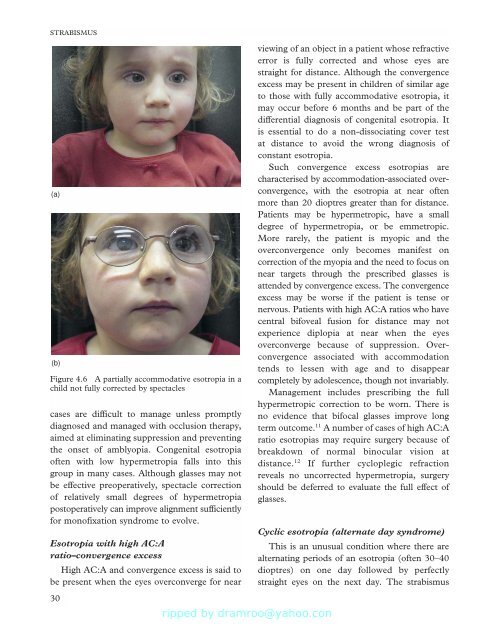Strabismus - Fundamentals of Clinical Ophthalmology.pdf
Strabismus - Fundamentals of Clinical Ophthalmology.pdf
Strabismus - Fundamentals of Clinical Ophthalmology.pdf
You also want an ePaper? Increase the reach of your titles
YUMPU automatically turns print PDFs into web optimized ePapers that Google loves.
STRABISMUS<br />
(a)<br />
(b)<br />
Figure 4.6 A partially accommodative esotropia in a<br />
child not fully corrected by spectacles<br />
cases are difficult to manage unless promptly<br />
diagnosed and managed with occlusion therapy,<br />
aimed at eliminating suppression and preventing<br />
the onset <strong>of</strong> amblyopia. Congenital esotropia<br />
<strong>of</strong>ten with low hypermetropia falls into this<br />
group in many cases. Although glasses may not<br />
be effective preoperatively, spectacle correction<br />
<strong>of</strong> relatively small degrees <strong>of</strong> hypermetropia<br />
postoperatively can improve alignment sufficiently<br />
for mon<strong>of</strong>ixation syndrome to evolve.<br />
Esotropia with high AC:A<br />
ratio–convergence excess<br />
High AC:A and convergence excess is said to<br />
be present when the eyes overconverge for near<br />
30<br />
viewing <strong>of</strong> an object in a patient whose refractive<br />
error is fully corrected and whose eyes are<br />
straight for distance. Although the convergence<br />
excess may be present in children <strong>of</strong> similar age<br />
to those with fully accommodative esotropia, it<br />
may occur before 6 months and be part <strong>of</strong> the<br />
differential diagnosis <strong>of</strong> congenital esotropia. It<br />
is essential to do a non-dissociating cover test<br />
at distance to avoid the wrong diagnosis <strong>of</strong><br />
constant esotropia.<br />
Such convergence excess esotropias are<br />
characterised by accommodation-associated overconvergence,<br />
with the esotropia at near <strong>of</strong>ten<br />
more than 20 dioptres greater than for distance.<br />
Patients may be hypermetropic, have a small<br />
degree <strong>of</strong> hypermetropia, or be emmetropic.<br />
More rarely, the patient is myopic and the<br />
overconvergence only becomes manifest on<br />
correction <strong>of</strong> the myopia and the need to focus on<br />
near targets through the prescribed glasses is<br />
attended by convergence excess. The convergence<br />
excess may be worse if the patient is tense or<br />
nervous. Patients with high AC:A ratios who have<br />
central bifoveal fusion for distance may not<br />
experience diplopia at near when the eyes<br />
overconverge because <strong>of</strong> suppression. Overconvergence<br />
associated with accommodation<br />
tends to lessen with age and to disappear<br />
completely by adolescence, though not invariably.<br />
Management includes prescribing the full<br />
hypermetropic correction to be worn. There is<br />
no evidence that bifocal glasses improve long<br />
term outcome. 11 A number <strong>of</strong> cases <strong>of</strong> high AC:A<br />
ratio esotropias may require surgery because <strong>of</strong><br />
breakdown <strong>of</strong> normal binocular vision at<br />
distance. 12 If further cycloplegic refraction<br />
reveals no uncorrected hypermetropia, surgery<br />
should be deferred to evaluate the full effect <strong>of</strong><br />
glasses.<br />
Cyclic esotropia (alternate day syndrome)<br />
This is an unusual condition where there are<br />
alternating periods <strong>of</strong> an esotropia (<strong>of</strong>ten 30–40<br />
dioptres) on one day followed by perfectly<br />
straight eyes on the next day. The strabismus










![SISTEM SENSORY [Compatibility Mode].pdf](https://img.yumpu.com/20667975/1/190x245/sistem-sensory-compatibility-modepdf.jpg?quality=85)





